 W
WAddi Lihtsi is an exclosure located in the Dogu'a Tembien woreda of the Tigray Region in Ethiopia. The area is protected by the local community.
 W
WAddi Meles is an exclosure located in the Dogu'a Tembien woreda of the Tigray Region in Ethiopia. The area is protected by the local community.
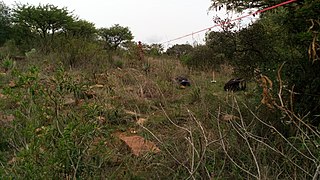 W
WAddilal is an exclosure located in the Dogu'a Tembien woreda of the Tigray Region in Ethiopia. The area has been protected since 1992 by the local community.
 W
WAerobic methane production is a potential biological pathway for atmospheric methane (CH4) production under oxygenated conditions. The existence of this pathway was first theorized in 2006. While significant evidence suggests the existence of this pathway, it remains poorly understood and its existence is controversial. Naturally occurring methane is mainly produced by the process of methanogenesis, a form of anaerobic respiration used by microorganisms as an energy source. Methanogenesis usually only occurs under anoxic conditions. By contrast, aerobic methane production is thought to occur in oxygenated environments under near-ambient conditions. The process involves non-microbial methane generation from terrestrial plant-matter. Temperature and ultraviolet light are thought to be key factors in this process. Methane may also be produced under aerobic conditions in near-surface ocean water, a process which likely involves the degradation of methylphosphonate.
 W
WAfedena is an exclosure located in the Dogu'a Tembien woreda of the Tigray Region in Ethiopia. The area has been protected since 2008 by the local community.
 W
WArctic methane release is the release of methane from seas and soils in permafrost regions of the Arctic. While it is a long-term natural process, methane release is exacerbated by global warming. This results in negative effects, as methane is itself a powerful greenhouse gas.
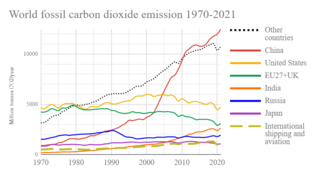 W
WThis is a list of sovereign states and territories by carbon dioxide emissions due to certain forms of human activity, based on the EDGAR database created by European Commission and Netherlands Environmental Assessment Agency released in 2018. The following table lists the 1990, 2005 and 2017 annual CO2 emissions estimates along with a list of calculated emissions per km² and emissions per capita.
 W
WThe CDP is an international non-profit organisation based in the United Kingdom, Germany and the United States of America that helps companies and cities disclose their environmental impact. It aims to make environmental reporting and risk management a business norm, driving disclosure, insight, and action towards a sustainable economy. Since 2002 over 8,400 companies have publicly disclosed environmental information through CDP.
 W
WA carbon footprint is the total greenhouse gas (GHG) emissions caused by an individual, event, organization, service, or product, expressed as carbon dioxide equivalent. Greenhouse gases, including the carbon-containing gases carbon dioxide and methane, can be emitted through the burning of fossil fuels, land clearance and the production and consumption of food, manufactured goods, materials, wood, roads, buildings, transportation and other services.
 W
WCarbon neutrality refers to achieving net zero carbon dioxide emissions by balancing carbon dioxide emissions with removal or simply eliminating carbon dioxide emissions altogether. It is used in the context of carbon dioxide-releasing processes associated with transportation, energy production, agriculture, and industrial processes. Carbon-neutral status can be achieved in two ways:Balancing carbon dioxide emissions with carbon offsets, often through carbon offsetting - the process of reducing or avoiding greenhouse gas emissions or sequestering (removing) carbon dioxide from the atmosphere to make up for emissions elsewhere. If the total greenhouse gasses emitted is equal to the total amount avoided or removed then the two effectively cancel each other out and the net emissions are 'neutral'. Reducing carbon emissions to zero through changing energy sources and industry processes. Shifting towards the use of renewable energy as well as nuclear power reduces GHG emissions. Although both renewable and non-renewable energy both produce carbon emissions in some form, renewable energy has a lesser to almost zero carbon emissions. which produces much less carbon emissions compared to fossil fuels. Making changes to current industrial and agricultural processes to reduce carbon emissions (for example, diet changes to livestock such as cattle can potentially reduce methane production by 40%. Carbon projects and emissions trading are often used to reduce carbon emissions, and carbon dioxide can even sometimes be prevented from entering the atmosphere entirely.
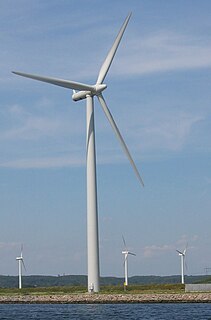 W
WA carbon offset is a reduction in emissions of carbon dioxide or other greenhouse gases made in order to compensate for emissions made elsewhere. Offsets are measured in tonnes of carbon dioxide-equivalent (CO2e). One tonne of carbon offset represents the reduction of one tonne of carbon dioxide or its equivalent in other greenhouse gases.
 W
WCh’elaqo is an exclosure located in the Dogu'a Tembien woreda of the Tigray Region in Ethiopia.
 W
WA coal-fired power station or coal power plant is a thermal power station which burns coal to generate electricity. Coal-fired power stations generate over a third of the world's electricity but cause hundreds of thousands of early deaths each year, mainly from air pollution.
 W
WAn emissions budget, carbon budget, emissions quota, or allowable emissions, is an upper limit of total carbon dioxide emissions associated with remaining below a specific global average temperature. An emissions budget may also be associated with objectives for other related climate variables, such as radiative forcing.
 W
WAn emissions target or greenhouse gas emissions reduction target is the central policy instrument of international greenhouse gas emissions reduction politics and a key pillar of climate policy.
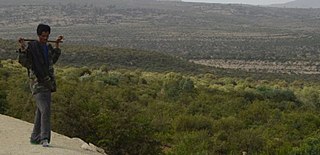 W
WThe EthioTrees Ecosystem Restoration Association, in short EthioTrees, established in 2016, is a project for environmental rehabilitation and woodland restoration in Dogu’a Tembien (Ethiopia).
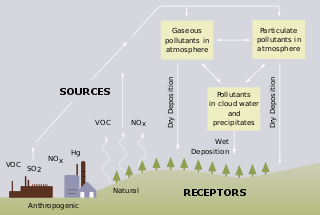 W
WFreshwater becomes acidic when acid inputs surpass the quantity of bases produced in the reservoir through weathering of rocks, or by the reduction of acid anions, like sulfate and nitrate within the lake. The main reason for freshwater acidification is atmospheric depositions and soil leaching of SOx and NOx. In an acid-sensitive ecosystem, which includes slow-weathering bedrock and depleted base cation pools, SOx and NOx from runoff will be accompanied by acidifying hydrogen ions and inorganic aluminum, which can be toxic to marine organisms. Acid rain is also a contributor to freshwater acidification, however acid rain is formed when SOx and NOx react with water, oxygen and oxidants within the clouds. In addition to SOx and NOx, the buffering capacity of soils and bedrocks within the freshwater ecosystem can contribute to the acidity of the water. Each freshwater reservoir has a capacity to buffer acids. However, with excess input of acids into the reservoir, the buffering capacity will essentially “run out” and the water will eventually become more acidic. Increase in atmospheric CO2 affects freshwater acidity very similarly to the way rising CO2 affects ocean ecosystems. However, because of the various carbon fluxes in freshwater ecosystems, it is difficult to quantify the effects of anthropogenic CO2. Finally, rising freshwater acidification is harmful to various aquatic organisms.
 W
WA gas-fired power plant or gas-fired power station or natural gas power plant is a thermal power station which burns natural gas to generate electricity. Natural gas power stations generate a quarter of world electricity and a significant part of global greenhouse gas emissions and thus global warming. However they can provide seasonal dispatchable generation to balance variable renewable energy where hydropower or interconnectors are not available.
 W
WGemgema is an exclosure located in the Dogu'a Tembien woreda of the Tigray Region in Ethiopia. The area has been protected since 1992 by the local community.
 W
WGreenhouse gas monitoring is the direct measurement of greenhouse gas emissions and levels. There are several different methods of measuring carbon dioxide concentrations in the atmosphere, including infrared analyzing and manometry. Methane and nitrous oxide are measured by other instruments. Greenhouse gases are measured from space such as by the Orbiting Carbon Observatory and networks of ground stations such as the Integrated Carbon Observation System.
 W
WHarehuwa is an exclosure located in the Dogu'a Tembien woreda of the Tigray Region in Ethiopia. The area has been protected since 1999 by the local community.
 W
WThe Integrated Carbon Observation System (ICOS) is a research infrastructure to quantify the greenhouse gas balance of Europe and adjacent regions. In November 2015 it received the international legal status of ERIC by decision of the European Commission. It is recognized by The European Strategy Forum on Research Infrastructures (ESFRI) as a landmark European research infrastructure. It consists of a harmonized network of long-term observation sites for the domains of atmosphere, ecosystems and ocean. The network is coordinated through its Head Office, the central data portal and central facilities including an atmosphere, ecosystem and ocean thematic center, and central analytical laboratories.
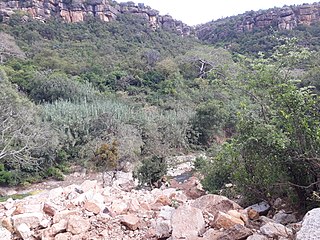 W
WKidmi Gestet is an exclosure located in the Dogu'a Tembien woreda of the Tigray Region in Ethiopia.
 W
WLafa is an exclosure located in the Dogu'a Tembien woreda of the Tigray Region in Ethiopia. The area has been protected since 1988 by the local community.
 W
WLandfill gas utilization is a process of gathering, processing, and treating the methane or another gas emitted from decomposing garbage to produce electricity, heat, fuels, and various chemical compounds. After fossil fuel and agriculture, landfill gas is the third largest human generated source of methane. Compared to CO2, methane is 25 times more effective as a greenhouse gas. It is important not only to control its emission but, where conditions allow, use it to generate energy, thus offsetting the contribution of two major sources of greenhouse gases towards climate change. The number of landfill gas projects, which convert the gas into power, went from 399 in 2005 to 519 in 2009 in the United States, according to the US Environmental Protection Agency. These projects are popular because they control energy costs and reduce greenhouse gas emissions. These projects collect the methane gas and treat it, so it can be used for electricity or upgraded to pipeline-grade gas. These projects power homes, buildings, and vehicles.
 W
WThis is a list of countries by total greenhouse gas (GHG) annual emissions in 2016. It is based on data for carbon dioxide, methane (CH4), nitrous oxide (N2O), perfluorocarbons (PFCs), sulfur hexafluoride (SF6) and hydrofluorocarbons (HFCs) emissions compiled by the World Resources Institute (WRI). The table below separately provides emissions data calculated on the basis of production, respectively consumption of goods and services in each country. WRI data includes emissions from land-use, land-use change and forestry, Global Carbon Project data does not. The unit used is megatonnes of carbon dioxide equivalent (MtCO2e) using the 100-year time horizon, like the UNFCCC. All countries which are party to the Paris Agreement report their greenhouse gas inventories at least biennially from 2024.
 W
WMay Be’ati is an exclosure located in the Dogu'a Tembien woreda of the Tigray Region in Ethiopia. The area has been protected since 1968 by the local community.
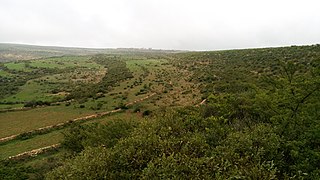 W
WMay Genet is an exclosure located in the Dogu'a Tembien woreda of the Tigray Region in Ethiopia. The area has been protected since 2010 by the local community.
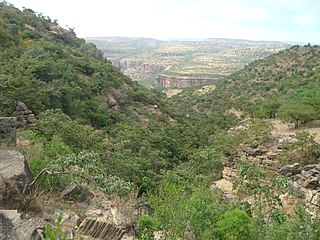 W
WMay Hib’o is an exclosure located in the Dogu'a Tembien woreda of the Tigray Region in Ethiopia. The exclosure holds a 70-metre long cave.
 W
WMi'am Atali is an exclosure located in the Dogu'a Tembien woreda of the Tigray Region in Ethiopia. The area has been protected since 2010 by the local community.
 W
WThe One-Tonne Challenge was a challenge presented by the Government of Canada in March 2004 for Canadians to reduce their greenhouse gas emissions by one tonne each year. The figure represented 20% of total greenhouse gas output by Canadians at the time and aimed to help the country reach its Kyoto Protocol emission reduction targets. The Liberal Government under Jean Chrétien and Paul Martin approved over $45 million to fund the program from 2003 to 2006.
 W
WA Representative Concentration Pathway (RCP) is a greenhouse gas concentration trajectory adopted by the IPCC. Four pathways were used for climate modeling and research for the IPCC fifth Assessment Report (AR5) in 2014. The pathways describe different climate futures, all of which are considered possible depending on the volume of greenhouse gases (GHG) emitted in the years to come. The RCPs – originally RCP2.6, RCP4.5, RCP6, and RCP8.5 – are labelled after a possible range of radiative forcing values in the year 2100. Since AR5 the original pathways are being considered together with Shared Socioeconomic Pathways: as are new RCPs such as RCP1.9, RCP3.4 and RCP7.
 W
WRoutine flaring, also known as Production flaring, is a method and current practice of disposing of large unwanted amounts of associated petroleum gas (APG) during crude oil extraction. The gas is first separated from the liquids and solids downstream of the wellhead, then released into a flare stack and combusted into earth's atmosphere; usually in an open diffusion flame. Where performed, the unwanted gas has been deemed unprofitable, and may be referred to as stranded gas, flare gas, or simply as "waste gas". Routine flaring is not to be confused with safety flaring, maintenance flaring, or other flaring practices characterized by shorter durations or smaller volumes of gas disposal.
 W
WSesemat is an exclosure located in the Dogu'a Tembien woreda of the Tigray Region in Ethiopia. The area has been protected since 1993 by the local community.
 W
WThe long tailpipe is an argument stating that usage of electric vehicles does not always result in fewer emissions compared to those from non-electric vehicles. While the argument acknowledges that plug-in electric vehicles operating in all-electric mode have no greenhouse gas emissions from the onboard source of power, it claims that these emissions are shifted from the vehicle tailpipe to the location of the electrical generation plants. From the point of view of a well-to-wheel assessment, the extent of the actual carbon footprint depends on the fuel and technology used for electricity generation, as well as the impact of additional electricity demand on the phase-out of fossil fuel power plants.
 W
WTogogwa is an exclosure located in the Dogu'a Tembien woreda of the Tigray Region in Ethiopia. The area has been protected since 1988 by the local community.
 W
WTukhul is an exclosure located in between the villages of Tukhul and Miheni in the Dogu'a Tembien woreda of the Tigray Region in Ethiopia. The area has been protected since 1998 by the local community.
 W
WThe Virgin Earth Challenge is a competition offering a $25 million prize for whoever can demonstrate a commercially viable design which results in the permanent removal of greenhouse gases out of the Earth's atmosphere to contribute materially in global warming avoidance. The prize was conceived and financed by Richard Branson, and was announced in London on 9 February 2007 by Branson and former US Vice President Al Gore.
 W
WYork Township is one of the sixteen townships of Belmont County, Ohio, United States. The 2010 census found 2,538 people in the township, 946 of whom lived in the unincorporated portions of the township.
 W
WZiban Dake is an exclosure located in the Dogu'a Tembien woreda of the Tigray Region in Ethiopia.